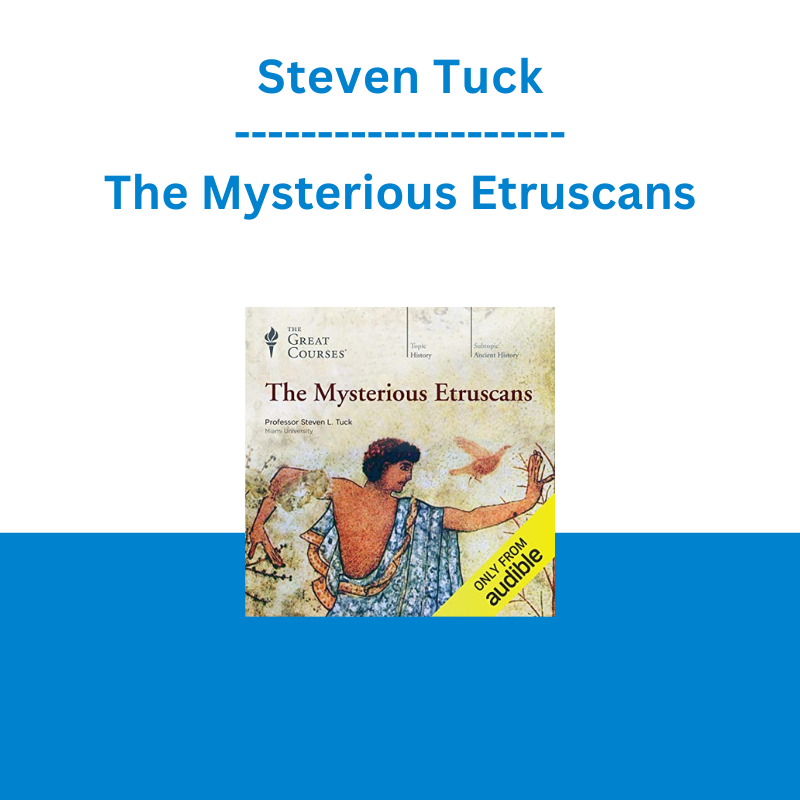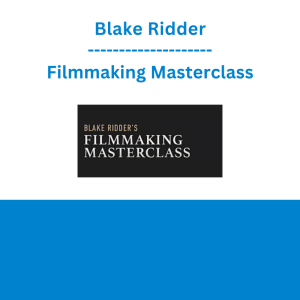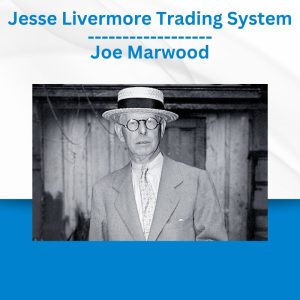*** Proof of Product ***
Exploring the Essential Features of “Steven Tuck – The Mysterious Etruscans”
The Mysterious Etruscans
Gain new insight into the foundations of Western civilization and discover how the Etruscans were a critical cultural conduit to our modern era.
LECTURE
Trailer
01:Between the Greeks and Romans
Meet the Etruscans. Although you may not know much about them, this opening lecture quickly shows how they served as a conduit between the Greeks and the Romans, influencing much of what we think of as Western civilization. Begin by surveying their world to gain context for this mysterious people….
32 min
02:Lost Cities of Tuscany
Although Etruscan cities no longer survive, we can learn much by studying the geography and the foundations of cities that were built over the Etruscan developments. Explore three Etruscan cities to find out how they were designed, and see what urban development tells us about the people and their impact on future civilizations….
31 min
03:Who Founded Rome?
Much of Rome’s geography, architecture, and artistic inscriptions suggest strong Etruscan influence. After discussing three Etruscan kings who ruled Rome, Professor Tuck reviews the evidence-particularly in some of the city’s prominent temples-that Rome was, in fact, largely founded as an Etruscan city….
34 min
04:Etruscan Cities of the Dead
Step into the Etruscan necropolis-a literal city of the dead-which tells us much about how the culture viewed the afterlife, social class, and more. In this first of three lectures on the dead, you’ll visit several ancient tombs to find out about how this mysterious people lived-and how their culture changed over time….
32 min
05:Etruscan Burial and Mourning
Funeral rites are some of the most conservative components of a culture. Because they change so slowly, we can learn much from looking at a society’s funerals. Here, examine Etruscan tomb paintings to learn about their religious rituals, from which we can deduce much of their beliefs, cultural priorities, and more….
34 min
06:Etruscan Afterlife
Round out your study of the Etruscan view of the dead and the afterlife by examining wall paintings. Reflect on some of the key symbols around the transition from the living to the dead-including divers, underworld guides, and kings. Then consider how the Etruscan afterlife compared to Greek beliefs and mythology….
29 min
07:Etruscan Gods and Goddesses
Shift your attention from the afterlife to survey Etruscan gods and goddesses. Learn about their pantheon and see how their deities compare to Greek and Roman gods, and consider what these deities indicate about the Etruscan worldview. See how collective action among the deities mirrored the culture’s government, family life, and more….
32 min
08:Divination: The Will of the Gods
One of the longest-lasting Etruscan legacies is divination, which had a profound influence on Rome. Venture into the Etruscan cosmos and find out how the interpretation of entrails, the flight of birds, and portents such as lightning strikes influenced their world. Then turn to blood sacrifices and other rituals designed to interpret the world and appease the gods….
32 min
09:Sanctuaries and Sacred Places
Sanctuaries reflect Etruscan religious beliefs and offer critical insight into their culture and politics. Examine the placement and design of several key sanctuaries, and contrast them with Greek temples. After reflecting on the geography of religious spaces, Professor Tuck turns to religious art and sculpture….
32 min
10:Etruscan Myths, Legends, and Heroes
While much of their art incorporates Greek elements-confusing archaeologists for decades-the Etruscans have their own distinct myths and legends. Here, delve into some of those stories and meet heroes such as the Vipinas brothers, who were a pair of folk heroes rooted in history. Explore the relationship between myth and history….
32 min
11:Greek Myth: Etruscan Tombs and Temples
Between the 7th and 3rd centuries BC, the Etruscans imported thousands of pieces of Greek pottery, and this ubiquity influenced much of their own art. Study the urns, tomb paintings, and other artworks to uncover how the Etruscans incorporated and reinterpreted Greek myths for their own purposes….
32 min
12:Greek Myth: Etruscan Homes
Continue your study of how Greek mythology influenced the Etruscans. Look at carvings, sculptural reliefs, bronze works, and other media that depict scenes from Greek myths. Examples include scenes from the Odyssey and the Iliad-adapted to Etruscan life in interesting ways….
32 min
13:Etruscan Language and Literature
The Etruscan language survives in more than 13,000 texts, from religious transcriptions on mummy linens to fascinating legal contracts written in stone. Because the Etruscans had a primarily oral culture, their writing tended to be analytical and straightforward, yet from it we can deduce much….
32 min
14:Etruscan Government
Reflect on the Etruscan form of government, which shifted from tyranny to a kind of city-state democracy. Examine some of the limitations of their democracy-especially in the realm of defense against Roman invaders. Then consider how much the Etruscan government and its symbols informed Rome, and therefore much of Western civilization….
31 min
15:Etruscan Warriors and Warfare
The Etruscan militaries were formidable, and their navies sailed around the Mediterranean, threatening many foreign settlements. Yet the military structure-or lack thereof-combined with a lack of any grand strategy, meant that the Etruscan military was more of a loose confederation than a unified force. Learn about their armor, battle tactics, and major confrontations….
32 min
16:Mediterranean Artisans and Merchants
Turn to the Etruscans’ extensive trade network across the Mediterranean, and consider some of their imports from the Greeks and Phoenicians-including pottery, ivory, glass, and more. Reflect on arts and crafts such as Greek vases, terra-cotta vessels, and pottery, and find out what Etruscan imports and exports might tell us about their politics and society….
31 min
17:Bronze, Terra-Cotta, and Portraiture
Dig deeper into Etruscan artwork and go inside the world of bronze metalworking and the terra-cotta industry. Professor Tuck shows you the patterns to their art, traces the Greek influence, and surveys the Etruscan gift for portraiture. You’ll study examples of their art and the techniques that went into making it….
31 min
18:Etruscan Sports and Spectacles
Sport and spectacle have long been part of human affairs. We associate gladiatorial combat with the Romans, but it actually originated with the Etruscans, who held such combats and chariot races as part of religious observances. Study the exciting world of Etruscan sports and find out the context surrounding different types of games….
30 min
19:The Etruscan Banquet
Banquets were the most significant social experience in the Etruscan world. Using tomb art as your guide, delve into the banquet world and see the customs for celebrating victories and observing religious events. You’ll also learn about the inclusion of women in these public events-unique in the ancient world….
31 min
20:Etruscan Women
One stark contrast between Etruscan society and the Greek and Roman worlds is the relative equality of Etruscan women to men. They appeared in public and even danced and banqueted in mixed company, inspiring strident condemnation from foreign authors. Here, review the role of women as priestesses, wives, mothers, and members of society at large….
31 min
21:Etruscan Families
Relative equality between men and women extended to family life, as well. In this lecture, take a look at the Etruscan family structure and compare it to the Greeks, Romans, and Hebrews. Professor Tuck uses tombs, funerary markers, myths, and more to present a picture of the Etruscan family, gender roles, and the status of children….
32 min
22:The Etruscan World Falls Apart
Many people assume that Etruscan culture simply died after the rise of Rome, but in truth, the culture lived on several centuries into Roman rule. Trace the history of the Etruscans’ final years, from the invasion of Rome to various resistance and revival movements to their eventual integration into the Roman world….
30 min
23:Etruscan Legacy in the Roman World
Tour Rome in the era of Augustus at the turn of the Common Era to reveal the Etruscans’ influence on all things Roman. While Etruscan culture officially faded away, you’ll see that without the Etruscans, Rome would lack many of its strongest attributes, from roads and bridges to military armor and togas to religion and sport….
31 min
24:Where Have the Etruscans Gone?
In this final lecture, you’ll trace the influence of Etruscan art and architecture in the Renaissance, when many exports of “Roman” culture were actually Etruscan. Then review what modern DNA research tells us about the origins and endings of the Etruscans-and the limits of our knowledge about this mysterious people even today….
34 min
DETAILS
Overview
The Etruscans were the original inhabitants of central Italy. Centuries before Rome’s rise, they built cities along fortified hilltops, developed a system of roads, and invented the Roman” arch. While they had their own system of government and their own myths, the Etruscans borrowed much from the Greeks-and gave much to the Romans. Without them, much of the foundations of Western civilization would disappear.”
About
Steven L. Tuck
We’re going to introduce the visual markers that serve to tell Romans about class interaction and the importance of urban spaces that create and impose Roman imperial identity and serve in ways that we would use literate works.
Professor Steven L. Tuck is Professor of Classics at Miami University. After earning his B.A. in History and Classics at Indiana University, he received his Ph.D. in Classical Art and Archaeology from the University of Michigan. He held the postdoctoral Arthur and Joyce Gordon Fellowship in Latin epigraphy at The Ohio State University.
An esteemed teacher, Professor Tuck received the 2013 E. Phillips Knox Teaching Award, Miami University’s highest honor for innovative and effective undergraduate teaching. In addition, the Archaeological Institute of America, North America’s oldest and largest organization devoted to archaeology, presented him with its Excellence in Undergraduate Teaching Award in 2014. He also has been named a Distinguished Scholar and an Altman Faculty Scholar at Miami University.
Professor Tuck has conducted archaeological fieldwork and research in Italy, Greece, England, and Egypt. He has directed more than a dozen study tours in Italy, concentrated on the city of Rome and the area around the Bay of Naples, including Pompeii, Herculaneum, and the Island of Capri. He has given more than 50 public lectures, including as a national lecturer for the Archaeological Institute of America.
Professor Tuck is the author of numerous articles featured in international journals on such topics as the lives of sailors in the Roman navy, the schedule of gladiatorial games at Pompeii, the decorative program of the amphitheater at Capua, the professional organizations of spectacle performers, Roman sculpture, and triumphal imagery across the ancient Roman world. He is the author of the forthcoming A History of Roman Art, a lavishly illustrated introduction to the topic.
Professor Tuck has taught two previous Great Courses: Pompeii: Daily Life in an Ancient Roman City and Experiencing Rome: A Visual Exploration of Antiquity’s Greatest Empire.
REVIEWS
Gavis mom
very interesting and elucidating
I loved Professor Tucks’s presentation style and his sense of humor. I also liked the format of the course by various topics, along with the maps and timelines. I have been interested in the Etruscans ever since visiting Tarquinia (thanks to our 10-year-old son’s suggestion) and this course was very enlightening.
Oxfreudian
Potomac, MD
Fabulous!
The second course we’ve watched by Professor Tuck. Knowledgeable, engaging, and good-humored! The one shortcoming was the lack of photos.
salubria1
All we know, is that we do not know.
The “Mysterious Etruscans” remain just as mysterious after taking this course. The topic is interesting and all aspects of ancient life are covered but the course raised more questions than it answered. I guess that is OK to get us thinking but it seems like there must be more surety than is presented here
Please see the full list of alternative group-buy courses available here: https://lunacourse.com/shop/










 Forexmentor - Recurring Forex Patterns
Forexmentor - Recurring Forex Patterns  Chris Capre - Advanced Price Action Ongoing Training & Webinars
Chris Capre - Advanced Price Action Ongoing Training & Webinars  Ed Ponsi - Forex Trading
Ed Ponsi - Forex Trading  Tony Bonacci - Last Longer In Bed For Men
Tony Bonacci - Last Longer In Bed For Men  Julie Stoian & Cathy Olson - Launch Gorgeous - Funnel Gorgeous Bundle
Julie Stoian & Cathy Olson - Launch Gorgeous - Funnel Gorgeous Bundle  Fred Haug - Virtual Wholesaling Simplified
Fred Haug - Virtual Wholesaling Simplified  Akil Stokes & Jason Graystone - TierOneTrading - Trading Edge 2019
Akil Stokes & Jason Graystone - TierOneTrading - Trading Edge 2019  Team NFT Money - Ultimate NFT Playbook
Team NFT Money - Ultimate NFT Playbook  Muddy Colors Pack 5,6 – Dan dos Santos, Vanessa Lemen, Annie Stegg, Greg Manches
Muddy Colors Pack 5,6 – Dan dos Santos, Vanessa Lemen, Annie Stegg, Greg Manches  Dave Landry - Stock Selection Course
Dave Landry - Stock Selection Course  Oliver Velez - Essential Strategy Of Trade For Life
Oliver Velez - Essential Strategy Of Trade For Life  Sovereign Man Confidential - Renunciation Video
Sovereign Man Confidential - Renunciation Video  Money Miracle - George Angell - Use Other Peoples Money To Make You Rich
Money Miracle - George Angell - Use Other Peoples Money To Make You Rich  Blake Ridder - Filmmaking Masterclass
Blake Ridder - Filmmaking Masterclass  Robert Fritz - Creating Your Life Course
Robert Fritz - Creating Your Life Course  SMB - Options Training
SMB - Options Training  Epic Mail Machine - $100K Deals With No Paid Ads
Epic Mail Machine - $100K Deals With No Paid Ads  Jesse Livermore Trading System - Joe Marwood
Jesse Livermore Trading System - Joe Marwood  Trade Like Mike - The TLM Playbook 2022
Trade Like Mike - The TLM Playbook 2022  Atlas API Training - API 570 Exam Prep Training Course
Atlas API Training - API 570 Exam Prep Training Course  Lucy Lopes - How To Start A Rental Car Company
Lucy Lopes - How To Start A Rental Car Company  Toshko Raychev - Profit System + ITF Assistant
Toshko Raychev - Profit System + ITF Assistant